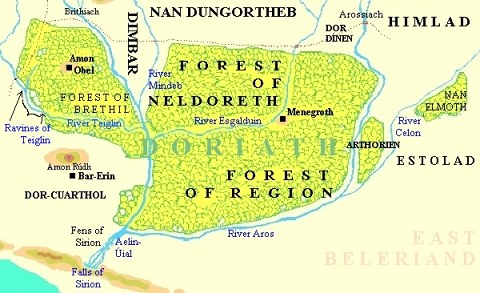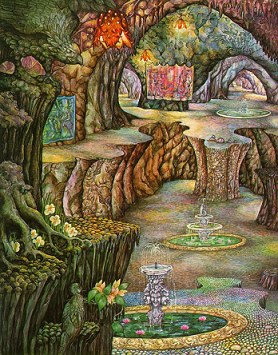Doriath
Doriath was the home of Elu Thingol and Melian the Maia, and was the first of the Hidden Kingdoms of Middle-earth. It was a great woodland that rose in the middle of Beleriand, on the rolling plains between Ered Gorgoroth and Andram the Long Wall. Its name meant “Land that is Fenced”, for Melian used her power to cast an unseen barrier called the Girdle of Melian over Doriath, so that no one could enter their realm without their permission.
Because of the isolation of Doriath, and the wide lands that separated it from other dwellings of the Sindar in Beleriand, its tongue was in many ways different from classical Grey-elven. It was deemed antique and archaic, peculiar only to those that were nurtured in the Hidden Kingdom. In Doriathrin, Doriath was named Eglador, Land of the Elves (literally ‘Land of the Forsaken’, from “Eglath,” the name they gave themselves after being left in Middle-earth.) The lands outside the Girdle they called Argador.

The Rivers of Doriath
Many rivers flowed through Doriath or near to its bounds. Greatest of these was mighty Sirion, beloved of Ulmo, which flowed from its springs in the Ered Wethrin down to the Bay of Balar.
The other rivers were:
– Taeglin, flowing from the Ered Wethrin. It had a small tributary named Celebros (Silver Foam) that flowed through Brethil.
– Mindeb, a short river that flowed right to the Sirion from the heights of the Ered Gorgoroth.
– Esgalduin, that passed through the forests of Doriath and divided them. The name meant “River under Veil”.
– Aros, the second longest river of Doriath, into which Celon the swift emptied.
The regions of Doriath
The northern region was named the Forest of Neldoreth, for great beeches grew abundantly in that part of the kingdom. It was bounded to the south and east by the dark waters of the Esgalduin. Between the Esgalduin and the Aros, to the east and south, was the wide and dense wood of holly-trees that was named the Forest of Region, which was the largest of Doriath’s divisions. Between the Aros and the Celon lay the small, forested land called Arthorien. Here dwelt those Elves that sought refuge after the first battle of Beleriand, the kin of the Green-elves of Ossiriand.
There was a narrow woodland that lay between the confluence of the Teiglin and the Sirion and the Meres of Twilight further downstream. This was named Nivrim, and it was encompassed by the Girdle. This Melian did in reverence to Ulmo, to make sure that at least a small part of the River Sirion was entirely enclosed in Thingol’s realm.
West of Sirion and north of Taeglin lay the woods of Brethil that were afterwards the home of the People of Haleth, the Haladin. It was not within the Girdle of Melian, yet it was acknowledged part of the realm of Doriath and only when King Thingol gave his permission did the Haladin settle there. But in Doriath itself, no Men lived.
Also, further to the east, beyond the river Celon were the dark woods of Nan Elmoth. It was here that Thingol and Melian met and fell in love, and thus it was special to them and their people, though none lived within its confines. Tall were its trees, but dark were the shadows that was laid on it. Later Thingol gave his leave to Eöl to dwell there, for a fee in the form of the sword Anglachel that became famous (or infamous) in the hands of Turin son of Hurin.
Beyond the forests was the land of Himlad that later became the fief of Celegorm and Curufin, sons of Fëanor.
Thus the realm of Thingol lay mostly east of Sirion and the Girdle of Melian was cast on its all about it; yet its territory stretched further both east and west.
Thingol – the righful king of all Beleriand?
“…and all the Elves of Beleriand, from the mariners of Cirdan to the wandering hunters of the Blue Mountains beyond the river Gelion, owned Elwë as their lord;…”
Indeed, Thingol did claim to be Lord of all Beleriand, from Dor-lomin to the north to the Mouths of Sirion in the south; from the shores of the Falas in the west to the lands beyond the river Gelion in the east. But it is obvious that his power only extended wherever his people, the Sindar, dwelt and still acknowledge his overlordship. When the Noldor came back to Beleriand, he gave them lands grudgingly, and only those he deemed he could not hold. Thus Maedhros said:
“A king is he that can hold his own, else his title is vain. Thingol does but grant us lands where his power does not run.
So in all practical purposes Thingol and Melian ruled only Doriath and its adjacent lands; elsewhere their power extended only to the Sindar wherever they still dwelt under a Sindarin lord, and only by virtue of their loyalty to him. In places where the Grey-elves were joined to the Noldor under Noldorin princes, Thingol ceased to be their king.
But he was still acknowledged as the rightful lord of all the Grey-elves (though not of Beleriand), and in matters that concerned them as a people, like the Kinslaying in Valinor, his commands were still followed by all Sindarin Elves.
“All Sindar shall hear my command that they shall neither speak with the tongue of the Noldor nor answer to it … And it came to pass even as Thingol has spoken; for the Sindar heard his word, and thereafter throughout Beleriand they refused the tongue of the Noldor…”
Menegroth

With Melian’s counsel in mind, Thingol built a mighty dwelling that would also be a refuge for his people when evil came. For this task he commisioned the Dwarven-smiths of Belegost, and in return the king paid them with great quantities of pearls. This was during the second age of Melkor’s captivity in Mandos.
In the fastness of Region on the banks of Esgalduin there was a rocky hill (while this hill has no name, it was supposedly called Cum-nan-Arasaith after the dwarves plundered it; the name meaning “Mound of Avarice”). There, both dwarves and elves laboured and delved the halls of Thingol.
Images of wonders and beauty adorned the many-pillared halls; and the pillars themselves were sculpted in the likeness of great beeches, from leaf to trunk, and were lit with lanterns that bore lights of gold. Myriads of fountains and watersprings were there also, and the floors were paved with marble. Its walls were said to be decorated with hangings made by Melian that told the history of Arda and its possible future.
Menegroth it was named, the Thousand Caves in Common Speech, a name that spoke volumes of the place. But beautiful as it surely was, Menegroth was also intended to be a stronghold against evil. The whole structure could be accessed only through a gate bridge that was built over the waters of the Esgalduin, and after which was built a mighty gate. Deep within the citadel were amouries and treasuries that held weapons.
“Now Thingol had in Menegroth deep amouries filled with great weapons: metal wrought like fishes’ mail and shining like water in the moon; swords and axes, shields and helms, wrought by Telchar himself or by his master Gamil Zirak the old, or by elven-wrights more skillful still.”
(It must be noted here that, despite being well furnished with arms, the Doriathrim never again came to open war after the first battle of Beleriand.)
But not all Menegroth was underground. Hírilorn, the great beech that had three trunks, grew on the side of the hill, and under it was a open court that Thingol and Melian sometimes sat. Hírilorn became the home of Lúthien when her father wished to keep her away from Beren.
When Menegroth was finished, it became truly the “fairest dwelling for any king that has ever been east of the Sea.” Many other dwelling places of the Elves in Middle-earth were fashioned after it – not the least being Nargothrond, stronghold of Finrod son of Finarfin. The abode of Thranduil, king of the Silvan Elves in Mirkwood, was also a copy of Thingol’s halls. But these were but pale shadows in comparison with the majesty and splendour of Menegroth during its noontide.
Only six of the race of Men saw Menegroth in its grandeur: Beren; then Turin, Grithnir and Grethron; and finally Morwen Eledhwen and Nienor.

Of Beren and the Quest of the Silmaril
Long was the peace and bliss of Doriath, but at last came the doom that none had foreseen save Melian. It started when Beren son of Barahir managed to enter Doriath. There, in the middle of the forests, he met Luthien, the daughter of Thingol and Melian, and the elf and man fell in love.
When Thingol learned of Luthien’s love for Beren, he was wrathful but stayed his judgement. However, he demanded a price if Beren should desire Luthien to be his wife, and that price was to take a Silmaril from the Iron Crown of Morgoth.
After the Quest had been completed, Thingol looked upon Beren with greater respect, and before the high throne in Menegroth, Beren son of Barahir took the hand of Luthien.
The death of Thingol and the First Battle of the Thousand Caves
After the great deeds of Beren and Luthien, a Silmaril was now in the keeping of Thingol. And it proved to be the cause of Doriath’s downfall when Thingol also gained possession of the Nauglamir, the great Necklace of the Dwarves.
Thingol desired that these two mighty and beautiful jewels should be joined, so that he may wear the Silmaril at all times. He called back in the Dwarves of Nogrod to do this work, but when Thingol learned that the dwarves purposed to keep it for themselves, he became angry with them. In turn, the dwarves of Nogrod slew the king of Doriath. When Thingol’s spirit departed to the halls of Mandos, Melian forsook Middle-earth, leaving Doriath without its protection, and open to its enemies.
The few dwarves that escaped Menegroth managed to reach their own kin in Nogrod, where through lies and half-truths fueled by their lust of wealth and vengeance, they persuaded their kinsmen to make war upon the Elves of Doriath. While the dwarves of Belegost did not join them, still a great host was mutered, and they came to besiege Menegroth. Valiantly the Elves fought, but in the end the Dwarves were victorious, and Menegroth was ransacked and plundered.
At this time, Beren and Luthien were living in Tol Galen in Ossiriand; and messengers out of Doriath told them all that had befallen. With the aid of the Green-elves, Beren and Dior then ambushed the diminished host of Nogrod on their way home. Beren slew their lord, and reclaimed the Nauglamir on which the Silmaril then shone.
Of Dior and the Ruin of Doriath
Dior then became the second king of Doriath, but his reign was to be brief. When Beren and Luthien died, the Nauglamir and Silmaril were given to him. He chose to wear the jewels, and so news of this came to the ears of the sons of Fëanor. They sent messengers to tell Dior of their claim to the Silmaril, but Dior did not answer.
And so the second battle of the Thousand Caves began, the Second Kinslaying. The sons of Fëanor surprised and overwhelmed the defenders of Menegroth, and eventually Dior and his wife Nimloth were killed. However, Celegorm was killed by Dior, and Caranthir and Curufin also fell in that battle. Dior’s sons Elured and Elurin were lost in the forest, possibly starving to death.
But Dior’s daughter, Elwing, managed to escape, and she fled south with the few survivors. Thay came at last to the mouths of Sirion and there built new a dwelling place. In time, they were joined by other refugees, both Men and Elves.
Menegroth was utterly destoyed, and Doriath was deserted. The realm never rose again from the ashes.
After the War of Wrath, Doriath, along with all Beleriand, foundered under the sea. For long ages, it had survived the onslaught of Morgoth, and in all probability would have suvived long enough to see the host of the Valar. Ironically, the same people who had made the realm great, the Elves and the Dwarves, were also the agents of its destruction.
Written by Nolimon
References:
– The Silmarillion
– Unfinished Tales
– The Peoples of Middle-earth (HoME 12)
– The War of the Jewels (HoME 11)
– The Lost Road and other Writings (HoME 5)









